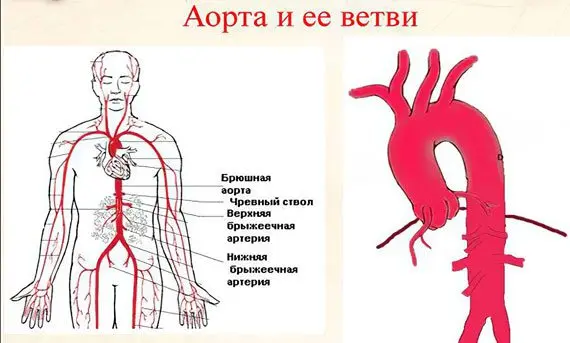Contents
- Atherosclerosis of the aorta of the heart – what is it?
- Symptoms of atherosclerosis of the aorta of the heart
- Causes of atherosclerosis of the aorta of the heart
- Diagnosis of atherosclerosis of the aorta of the heart
- Treatment of atherosclerosis of the aorta of the heart
- Prevention of atherosclerosis of the aorta of the heart
Atherosclerosis of the aorta of the heart – what is it?
Atherosclerosis of the aorta of the heart – This is a disease that affects the largest elastic artery in the human body and has a chronic course. The disease is characterized by the formation of one or more foci of lipid deposits on the inner lining of the cardiac aorta, called atheromatous plaques. As the disease progresses, connective tissue proliferation and calcification of the aortic walls occur, which causes its deformation, although slowly, but steadily progressing. As a result, the lumen narrows to complete obliteration, which causes the heart and underlying organs that feed on it to suffer, which begin to experience a growing lack of blood supply.

In addition, blockage of the aorta of the heart by a thrombus is possible. The result of occlusion of the lumen of the artery is myocardial infarction.
The aorta itself consists of two sections and is divided into the thoracic and abdominal parts. The thoracic aorta is the initial section of the cardiac aorta, and the arteries departing from it supply blood to the upper half of the body and the organs located there. The abdominal aorta is the end section that supplies blood to the organs located in the lower part of the body, namely, in the abdominal cavity and pelvis.
According to statistics, atherosclerosis of the aorta of the heart most often affects men who have reached the age of 50 years and older, as well as women who have crossed the line of 60 years.
Symptoms of atherosclerosis of the aorta of the heart

The disease at the initial stages develops almost asymptomatically, sometimes the period of plaque formation can take several decades. Depending on which part of the aorta of the heart was affected, a person will experience certain unpleasant sensations.
If the thoracic aorta has undergone pathological changes, then the person will complain of the following symptoms:
Pain in the chest, which occurs with a certain frequency and is of a burning nature;
Increase in systolic blood pressure;
Frequent dizziness;
Difficulty swallowing food;
Premature appearance of gray hair and early aging;
Hair growth in the ears;
The formation of wen on the face;
The appearance of a light strip on the outer shell of the iris of the eye.
When atherosclerosis affects the abdominal aorta of the heart, a person may complain of:
Stool disorders, expressed in the periodic change of diarrhea with constipation;
Bloating, increased gas formation;
Progressive weight loss;
Paroxysmal aching pains of low intensity that occur after eating and stop after two hours;
Severe abdominal pain that is not relieved with painkillers may indicate the development of inflammation of the abdominal organs or the peritoneum itself, which occurs as a result of thrombosis;
Increased blood pressure;
The development of renal failure.
Causes of atherosclerosis of the aorta of the heart
Among the reasons leading to the development of atherosclerosis of the aorta of the heart, we can distinguish:
The patient’s age is over 40 years. The risk of atherosclerosis increases in parallel with the lived years;
Gender (men under the age of 55 suffer from atherosclerosis of the aorta of the heart much more often than women);
The hereditary factor, that is, the risk of developing atherosclerosis increases in those families where relatives suffered from a similar disease;
Bad habits, in particular, smoking. The tar and nicotine contained in the smoke contribute to spasms of the coronary arteries, increasing the risk of coronary artery disease and increasing blood pressure;
An irrationally selected diet with a predominance of animal fats in the menu;
Low physical activity, which leads to the formation of diabetes mellitus and obesity, as well as to a decrease in the rate of metabolic processes and the formation of atherosclerotic plaques;
High blood pressure;
Frequent infections and intoxication of the body.
Diagnosis of atherosclerosis of the aorta of the heart
As a rule, it is almost impossible to suspect the development of atherosclerosis of the aorta of the heart only according to the patient’s complaints, which is why regular examination by a therapist and identification of concomitant risk factors is so important. Among them, an increase in blood pressure, an increase in body weight, an increase in the level of cholesterol in the blood.
If there is a suspicion of the presence of atherosclerosis of the aorta, then the following clarifying methods are used:
ECG, supplemented by the results of ultrasound of the aorta and heart;
Coronagraphy and angiography;
Duplex and triplex scanning;
MRI.
Treatment of atherosclerosis of the aorta of the heart

The sooner treatment is started, the greater the effect will be. The therapy is aimed, firstly, at lowering the level of cholesterol in the blood, secondly, at stimulating its speedy removal from the body and, thirdly, at eliminating concomitant pathologies.
There are certain groups of drugs used to treat atherosclerosis of the aorta of the heart, among them:
Statins that help lower blood cholesterol levels, but have a large number of side effects and contraindications (pravachol, zocor, mevacor);
Derivatives of nicotinic acid and nicotinic acid itself (vitamin B3), which are also aimed at lowering the level of cholesterol and triglycerides in the blood, have anti-teratogenic properties and contribute to the production of “good” cholesterol. However, given that the dosage should be taken from 50 to 300 daily norms, adverse reactions are inevitable;
Fibrates aimed at reducing the synthesis of the body’s own fats (miscleron, gevilan, atromid);
Bile acid sequestrants that promote their excretion and lower blood cholesterol levels (cholestide, cholestyramine).
In addition to the above medications, the patient will be given recommendations for changing the diet, it is recommended to adhere to the Mediterranean diet. Often, the doctor prescribes vitamin and mineral complexes, omega-3 preparations (for example, Omacor).
In addition to the main treatment, herbal preparations can be recommended, such as: Inflaminat, Ravisol, Revitl Garlic Pearls.
In some cases, medical treatment alone is not enough and surgery may be required. It is necessary when there is a threat to human life, for example, myocardial infarction, renal ischemia, or another formidable complication of atherosclerosis of the aorta of the heart.
It is difficult to give a prognosis for recovery from atherosclerosis, it all depends on the degree of development of the disease. However, with the timely elimination of risk factors, mortality rates are significantly reduced. Therefore, the prevention of atherosclerosis is so important.
Prevention of atherosclerosis of the aorta of the heart
Preventive measures are aimed at preventing an increase in the level of cholesterol in the blood and preventing it from being deposited on the walls of the aorta.
To reduce the risk of developing atherosclerosis, you must:
Give up bad habits, especially smoking and drinking alcohol;
Rethink your approach to nutrition. Although the proportion of cholesterol that enters the bloodstream from food is not too large and is only 25%, nevertheless, as a preventive measure, it will not be superfluous to switch to the Mediterranean diet;
If at least one of the signs indicating problems in the work of the aorta of the heart has been noticed, you should consult a doctor as soon as possible and undergo a comprehensive diagnosis. Timely treatment of concomitant diseases will reduce the risk of developing atherosclerosis of the aorta of the heart. We are talking about diabetes, hypertension, obesity;
Maintaining an active lifestyle, moderate physical activity, engaging in accessible sports will make it possible, if not to avoid, then significantly delay the time of manifestation of the disease;
It is worthwhile to undergo annual examinations at the clinic at the place of residence, which is especially important for people who have crossed the line of 40 years.
Compliance with these preventive measures will reduce the risk of developing atherosclerosis of the aorta of the heart, avoid serious complications of the disease and maintain a high quality of life.









